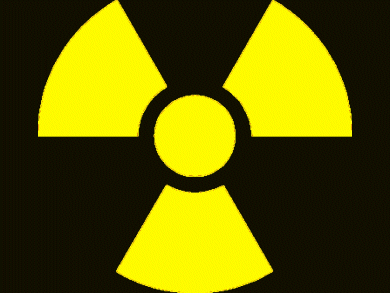Radiation
Radioactive materials that decay spontaneously produce ionizing radiation. When it interacts with tissues in the human body it can cause significant damage to the body’s internal chemistry, breaking the chemical bonds between the atoms and molecules that make up cells and tissues. At the beach, UV radiation leads to sunburn, but radioactive radiation also damages (essential) molecules inside the body.
As radiation is a natural component of our environment – there has always been cosmic radiation from outer space as well as radioactive material on earth – humans have always been exposed to this background radiation and the body is capable of repairing much of the damage caused by radiation.
A flight from Frankfurt to New York, e.g., results in an effective dosis of approx. 75–150 mS. As the radiation dose and exposure time increase, the chance of a permanent effect on a person is increased. Regions of the body that are most vulnerable to radiation damage include the cells lining the intestine and stomach, and the blood-cell-producing cells in the bone marrow.
Inhalation
Besides exposure to radiation inhalation of radioactive particles is a problem. In the case of a nuclear fusion, the nuclear fuel elements are destroyed and the containing radioactive substances (uranium, plutonium, krypton, strontium, cesium) are released.
Gaseous substances like krypton and xenon flow into the atmosphere as well as low-volatile substances like iodine or cesium. Less volatile substances like strontium, uranium, plutonium accumulate to dust particles.
Radioactive Isotopes
The radioactive isotopes of most significant concern in a nuclear power accident are iodine-131 and cesium-137. Both decay by beta emission.
Iodine-131, produced in a power station as a 3 % fission product, has a half-life of 8 days, meaning half of it will have decayed after 8 days, and half of that in another 8 days, etc. Therefore, it is of greatest concern in the days and weeks following an accident. It is also volatile so will spread easily.
In the human body, iodine is taken up by the thyroid, and becomes concentrated there, where it can lead to thyroid cancer in later life. Children who are exposed are more likely than adults to get cancer later in life.
To guard against the absorption of iodione-131, people can proactively take potassium iodine pills so the thyroid becomes saturated with non-radioactive iodine and is not able to absorb any iodine-131. However, excessive iodine can trigger autoimmune thyroid disease and hypothyroidism.
Cesium-137 has a half-life of about 30 years, so will take more than a century to decay by a significant amount. Living organisms treat cesium-137 as if it was potassium, and it becomes part of the fluid electrolytes and is eventually excreted. Cesium-137 is passed up the food chain. It can cause many different types of cancer.
References
- Health Physics Society (HPS), Herndon, VA, USA. (accessed March 30, 2011)
- Factsheet: Explaining Japan Nuclear Reactor Disaster, Union of Concerned Scientists, Massachusetts Institute of Technology (MIT), USA, 2011. (accessed March 30, 2011)
Also of Interest
- How Do Nuclear Plants Work?
- Nuclear Meltdown
General facts on a nuclear meltdown


